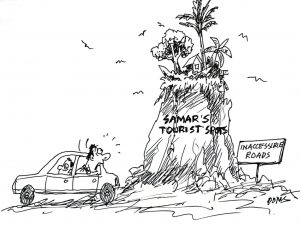Many of us know that Samar Island boasts an array of natural beauty spots that remain largely untouched and unexplored. With pristine beaches, majestic waterfalls, lush forests, and historical landmarks, Samar holds a treasure trove of attractions that could rival the country’s more famous destinations. But the island’s potential for tourism remains underutilized, primarily due to inadequate infrastructure and accessibility issues.
The island’s diverse landscapes offer unique experiences for nature lovers and adventure seekers. Calbiga Caves, one of the largest cave systems in Southeast Asia, promises an exhilarating spelunking experience. The picturesque Sohoton Natural Bridge National Park, with its stunning limestone formations and pristine waters, could draw eco-tourists and photographers alike. Moreover, the untouched beaches of Marabut and the breathtaking Lulugayan Falls in Calbiga could easily become major attractions if properly promoted and developed. These sites, if made accessible, could contribute significantly to the local economy and enhance the Philippines’ overall tourism portfolio.
Improving transportation infrastructure is crucial for unlocking Samar’s tourism potential. Currently, many of these beauty spots are difficult to reach due to poor road conditions and limited public transportation options. The government must ensure that tourists can reach these destinations safely and comfortably. This would not only boost tourist arrivals but also improve the quality of life for local residents by providing better connectivity and promoting regional development.
In addition to infrastructure improvements, strategic marketing, and community involvement are essential for sustainable tourism development. The government and private sector must collaborate to create awareness about Samar’s attractions through targeted marketing campaigns. Showcasing the island’s unique offerings at international travel fairs, social media platforms, and travel blogs can attract a global audience.
Furthermore, involving local communities in tourism activities can ensure that development is inclusive and benefits the residents. Training programs for tour guides, hospitality services, and eco-tourism initiatives can empower locals and promote a sense of pride and ownership over their natural heritage.
Ultimately, developing Samar Island for tourism is not just about attracting visitors; it is about preserving and celebrating its natural and cultural wealth. By investing in infrastructure, promoting sustainable practices, and engaging the local community, Samar can become a shining example of responsible tourism. The island has the potential to offer unparalleled experiences that showcase the best of what the Philippines has to offer, creating lasting memories for tourists and generating economic growth for the region.
Now is the time for the government to take decisive action and unlock the full potential of Samar Island as a premier tourist destination. The government must prioritize developing transportation highways and making these scenic spots accessible to both local and international tourists.




